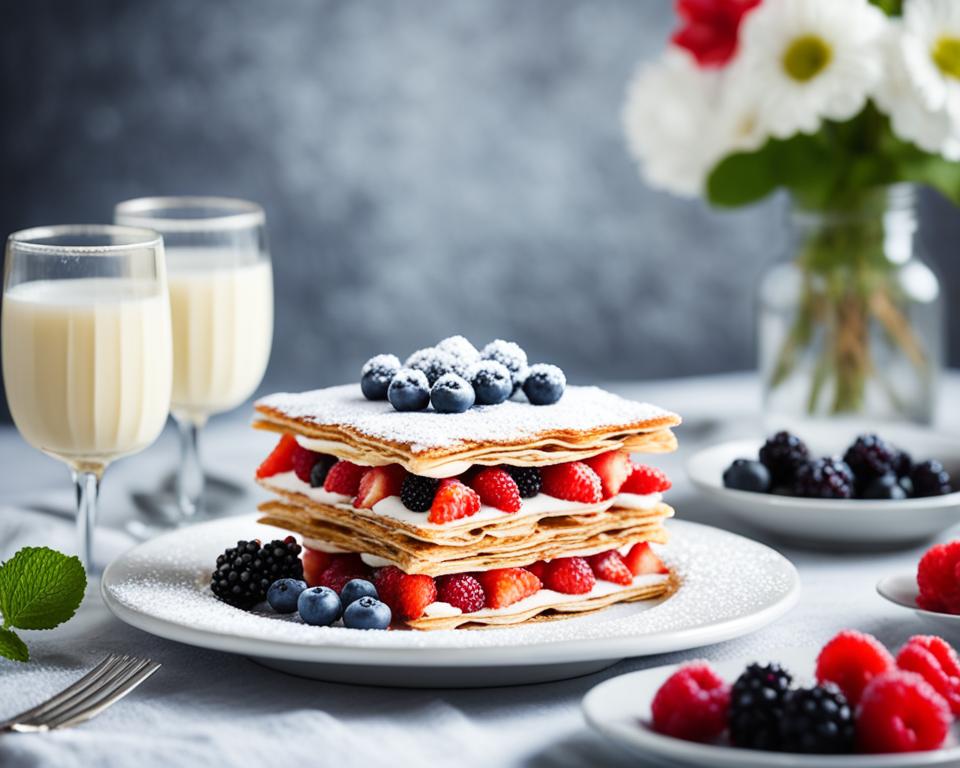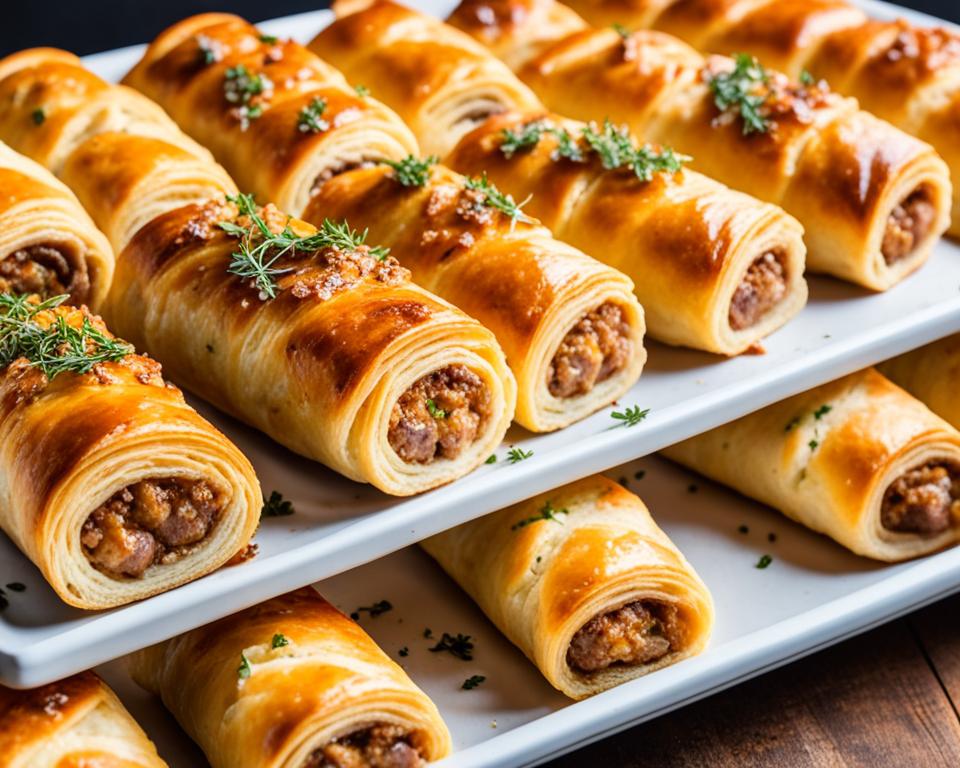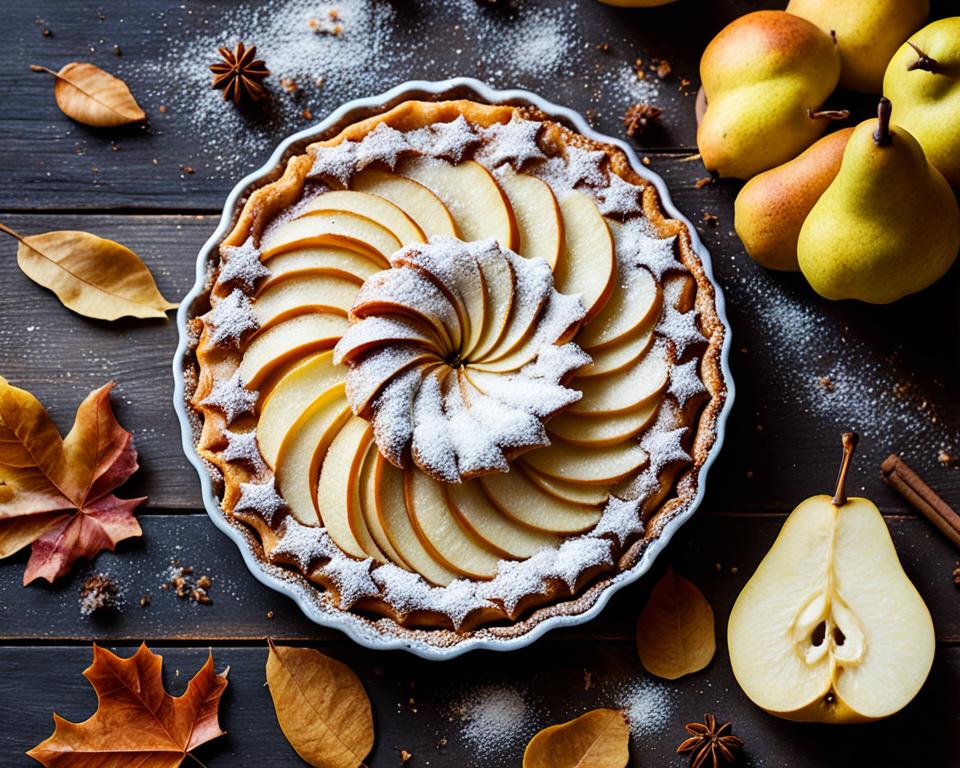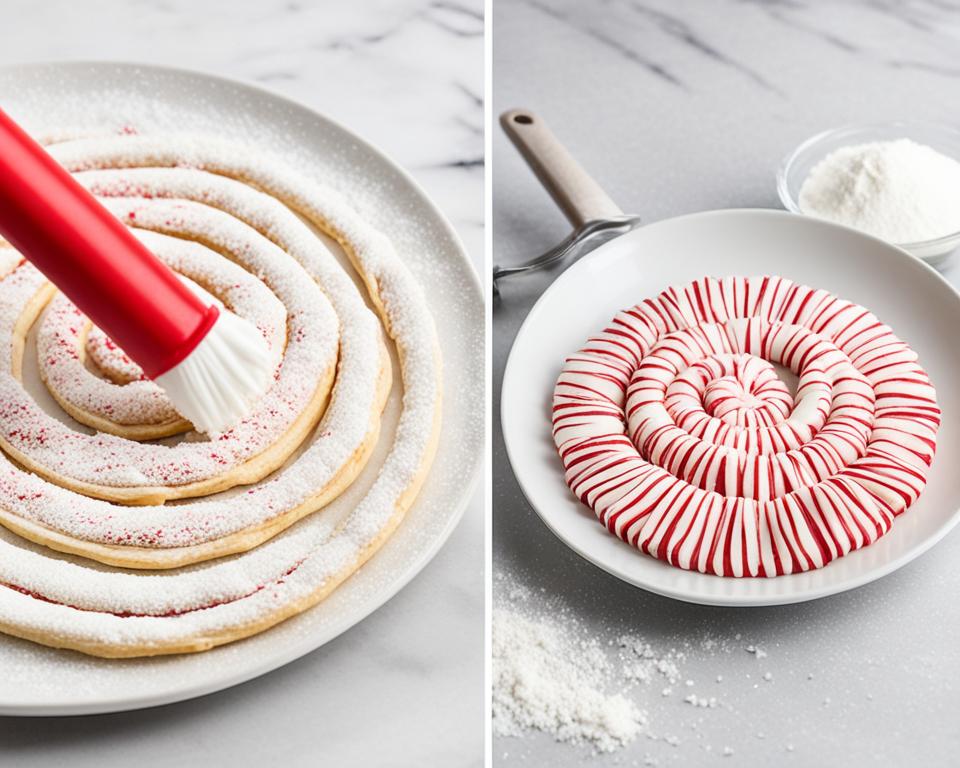Embark on a culinary voyage to the heart of France with this sumptuous Flaky Mille-Feuille recipe. Celebrated as an iconic symbol of French pastry artistry, the Mille-Feuille (pronounced meel-foy) is a dessert lover’s dream come to life. Layers of buttery puff pastry flirt with the lightness of air, sandwiching a rich, velvety vanilla cream, delivering a symphony of textures and tastes. This guide unveils the secrets to creating this delicious pastry dessert at home, engaging all your senses. From preheating the oven to the final dusting of sugar, crafting homemade Mille Feuille is an adventure in dessert perfection.
Imagine the delight of your guests as they indulge in each crisp layer, discovering the depths of flavor that only true French pastry can provide. Whether it’s an intimate dinner or a grand gathering, mastering this Mille feuille recipe promises a show-stopping finale to any meal. Now, with the proficiency of chefs at your fingertips, the art of creating this masterpiece is demystified, making every slice as memorable as a stroll down the Champs-Élysées.
Key Takeaways
- Discover the art of making a Flaky Mille-Feuille, a cornerstone of classic French pastry.
- Learn the essential steps for a foolproof Mille feuille recipe that brings elegance to your dining table.
- Impress your guests with a delicious pastry dessert that looks as exquisite as it tastes.
- Embrace the joy of baking with tips and techniques tailored for the perfect layered pastry.
- Combine visual appeal with delightful flavors, mastering a French culinary tradition in the comfort of your home.
Unveiling the Delights of French Pastry
The realm of French pastry is a mesmerizing one, brimming with the finesse and splendor that gourmet desserts are celebrated for. Steeped in tradition and culinary artistry, these confections are not merely treats; they are a voyage into the elegance of French culture. Among the pantheon of delectable delights, the Mille Feuille stands as an embodiment of the craftsmanship and heritage that make Classic French desserts a universal indulgence.
In the hands of a skilled patissier, ingredients transform into layered marvels, captivating the senses. For the home chef, the allure of replicating such artistry might seem daunting, yet it is surprisingly within reach. The key lies in the symphony of layers; where delicate, flaky tiers of puff pastry dessert converge with creamy, opulent fillings, yielding an experience that is both decadent and refined.
The Charm of Classic French Desserts
At the heart of French pastry lies the layered dessert, a concept that combines texture with flavor to produce creations that are as beautiful to behold as they are to consume. The Mille Feuille, with its Mille feuille layers, offers a testament to the satisfaction one derives from crisp pastry, mingling with silken cream, each bite a whisper of the expertise behind its inception. It is this charm that beckons culinary enthusiasts to partake in the ritual of crafting these classic sweets.
The Elegance of Puff Pastry Desserts
A puff pastry dessert is the epitome of baking elegance, attributable to its versatility and the captivating layers that puff up into a golden canvas of flavor. It allows for an artful construction, wherein each feuilletage or leaflet is distinct yet harmoniously integrated. Achieving such a masterpiece requires patience and precision, but when the layers of a Mille Feuille are perfectly rendered, one can’t help but marvel at the result—a beautifully structured, Classic French dessert known for its luxurious texture and palatable subtlety.
Immerse yourself in the art of French pastry with every slice of Mille Feuille, a blissful journey through the essence of famed patisseries—right from your own kitchen.
A Detailed Look at Perfect Flaky Mille-Feuille
The mastery of homemade mille feuille is a craft admired in the culinary world, characterized by its iconic flaky layers and indulgent cream. A rendezvous of intricate details and precision, this layered dessert personifies elegance and sumptuousness in every bite. To achieve the hallmark texture synonymous with mille feuille layers, a specific method in preparation is essential—one that balances patience with technique, resulting in a dessert that captivates both the eye and palate.
Understanding the Layers of Delicacy
The allure of the Flaky Mille-Feuille is undeniably in its layers; the resplendent structure that when perfected, boasts an unparalleled crispness. To begin, a foundational layer of puff pastry is prepared with meticulous attention. The dough is thawed, rolled, and pricked to allow for an even rise that culminates in feather-like sheets after baking. Each baked layer, once cooled, is a testament to the finesse required in crafting a truly emblematic Flaky Mille-Feuille.
The Artistry in Preparing Mille Feuille Layers
The artistry of creating a layered dessert like mille feuille extends beyond mere baking. It involves the delicate process of assembling these crisp sheets with the finesse of a painter’s brush. Chef John’s recommended vanilla bean pastry cream acts as the perfect complement to the dough’s crispness, providing the richness and flavor that define this classic dessert. The precision in slicing the pastry into uniform rectangles not only serves the purpose of aesthetics but supports an even distribution of the creamy vanilla bean filling, ensuring every layer coalesces into a harmonious stack ready to delight the senses.
| Preparation Step | Time Required |
|---|---|
| Thawing Puff Pastry Dough | Approx. 45 mins |
| Prepping Pastry for Baking | 10 mins |
| Baking Time | 15-25 mins (Depending on Baking Step) |
| Cooling Period | Until Completely Cool |
| Slicing into Rectangles | Varies |
Adhering to such meticulously plotted times ensures that your homemade mille feuille will have the ideal texture—flaky yet tender. This layered dessert then becomes not just a sweet conclusion to your meal but a majestic tribute to the art of French patisserie.
Mastering the Mille Feuille Recipe
Aspiring home bakers will find joy in the intricate journey of mastering the traditional Mille feuille recipe. This treasured French pastry is a testament to the sublime balance between delicate puff pastry and rich, creamy fillings. The process of crafting such a delicious pastry dessert begins with a gentle hand and a discerning eye for detail, making the creation accessible and supremely satisfying for bakers of all levels.

Every step, from dough preparation to the final assembly, requires precision that, when executed with care, coalesces into a confectionery marvel. The light and airy layers are the very essence of what makes a puff pastry dessert so indulgently pleasurable, while the fillings imbue it with an opulent richness. To ensure that the pastry maintains its signature flakiness, Chef John’s methodology—meticulously crafted and outlined—is followed, highlighting the structured approach necessary for achieving this classic delight.
- Meticulously thaw and prepare the puff pastry dough to ensure even layers.
- Precisely bake until golden brown, then allow to cool for the perfect crisp texture.
- Layer with rich vanilla bean pastry cream, synonymous with French pastry traditions.
- Optionally embellish with white or chocolate icings, adding a visually striking element.
Throughout the years, what has remained unchanged is the allure of the Mille Feuille—undeniably tied to its flaky layers and creamy heart, a signature of authentic French pastry craftsmanship. Whether it’s adorned with the simplicity of confectioner’s sugar or the richness of chocolate fondant, a masterfully created Mille feuille recipe is a revered addition to any dessert table, ready to transport its connoisseurs to the quaint streets of Paris.
Ingredients Vital for the Flaky Mille-Feuille
At the core of every iconic Flaky Mille-Feuille, there are two essential components that lay the groundwork for its delicate texture and rich flavor. These are none other than the Frozen Puff Pastry Dough and the luxurious Vanilla Bean Pastry Cream. Let’s explore how each of these ingredients plays a pivotal role in creating the perfect puff pastry dessert.
Frozen Puff Pastry Dough: Foundation of Flakiness
Frozen puff pastry dough offers both professional and home bakers the convenience and uniformity essential to a successful Mille-Feuille. This dough, when baked, should rise into many delicate layers that are both visually and texturally pleasing. Its flaky nature is what makes it the ideal base for creating the desired luxurious feel in every bite of the Flaky Mille-Feuille.
Vanilla Bean Pastry Cream: The Heart of Mille Feuille
Vanilla Bean Pastry Cream is the luscious, creamy heart that syncs beautifully with the crisp layers of puff pastry, setting the Flaky Mille-Feuille apart from all other pastries. Real vanilla beans, steeped into the cream, release their aromatic compounds, imbuing the dessert with a depth of flavor that is both subtle and profound—a flavor that is synonymous with an authentic, artfully crafted French pastry.
Step-by-Step Guide to Creating Puff Pastry Perfection
The journey to a homemade Mille Feuille, with its signature flaky Mille-Feuille layers, begins long before the oven preheats. It starts in the quiet anticipation of thawing puff pastry sheets, a process that sets the stage for the grandeur to come. For those embarking on this endeavor, patience and precision are essential in drawing out the soul of a puff pastry dessert that whispers of French patisseries and sun-kissed mornings in Paris.
Thawing and Preparing Puff Pastry Sheets
Aspiring artisans of the kitchen will find harmony in the thawing of the puff pastry dough—a crucial foreplay to the baking symphony. This passive yet vital prelude to perfection mandates careful adherence to timing, for the thawed dough’s pliability is the canvas upon which the masterpiece is built. Thawing it just right, allows the seams to part with gentle guidance, laying the groundwork for what will become delicate Mille feuille layers.
Baking to Achieve Golden Elegance
Upon the chilled platform of puff pastry, dreams are etched with fork tines and sprinkled with a hint of sugar, marking the advent of transformation. The pastry, now bedecked with sugary freckles, enters a heated alchemy under the discerning gaze of the baker. Through the glass, a golden elegance emerges, a hallmark of the homemade mille feuille. This alchemical phase is neither rushed nor overstretched, adhering to the sacred intervals of time that bestow upon the pastry a crispness sought by many but achieved by few. This marks the point of no return in your dance with puff pastry perfection.
| Step in Process | Action | Duration |
|---|---|---|
| Thawing Dough | Allow to rest at room temperature | Approx. 45 mins |
| Prepping for Bake | Separate, prick, and sprinkle sugar | 10 mins |
| Primary Bake | Bake covered with parchment and foil | 15 mins |
| Secondary Bake | Bake uncovered to golden brown | 10-15 mins |
| Cooling | Transfer to a cooling rack | Until completely cool |
In this ceremonious labor, the joy of creating puff pastry dessert unfolds across the kitchen. With each minute that passes, the pastry ascends towards its flaky destiny, emerging as the embodiment of your culinary ardor. In every golden layer resides the promise of a Mille-Feuille that shall bear the fruit of your efforts—an offering to time-honored traditions and your own creative spirit.
Culinary Techniques: Assembling the Mille Feuille Layers
Assembling a homemade mille feuille is akin to painting a masterpiece; it’s an art form that requires a steady hand, a keen eye for detail, and an understanding of how each element contributes to the final creation. This section dives into the precise methods that transform simple ingredients into an intricate layered dessert. With the right techniques, your mille feuille will not just be a dessert; it will be a visual and gastronomic representation of the elegance inherent in celebrated French pastry traditions.
Cutting with Precision: Size and Shape Matters
The Mille feuille layers sit at the heart of this classic confection. Precision in cutting is essential to ensure each piece is uniform, paving the way for a dessert that is as pleasing to the eye as it is to the palate. Remember, even the slightest variation in size and shape can impact the overall texture and presentation of your layered creation. To achieve perfection, use a sharp serrated knife and measure each piece meticulously before applying a gentle sawing motion to cut through the delicate pastry.
Piping the Pastry Cream Evenly
An evenly piped layer of vanilla bean pastry cream is what gives the layered dessert its luxurious mouthfeel. Successful piping distributes the cream uniformly over each base, creating the flawless balance between the crisp puff pastry and the creamy filling. For a neat presentation, use a piping bag fitted with a round tip, and apply consistent pressure to release an equal amount of pastry cream across the surface. As with any fine French dessert, avoiding haste and giving careful attention to technique will yield the most alluring and delicious results.
| Assembly Step | Instrument | Technique |
|---|---|---|
| Cutting Puff Pastry | Sharp serrated knife | Gentle sawing motion |
| Piping Pastry Cream | Piping bag with round tip | Even pressure and distribution |
With these techniques, assembling a homemade mille feuille is transformed from a daunting task to a delightful activity. Whether you are a seasoned baker or new to the world of French pastry, your culinary prowess will be on full display, delivering a dessert that whispers of the storied patisseries of Paris – all from the warmth of your own kitchen.
Expert Tips to Enhance Your Homemade Mille Feuille
The art of creating the perfect Flaky Mille-Feuille does not end with the preparation of layers; the finesse of assembly and decoration plays an equally pivotal role. Crafted with precision, your homemade Mille feuille recipe can surpass even the finest of French pastry shops in both taste and presentation. Below are sagacious tips that marry tradition with technique, ensuring your delicious pastry dessert remains a cut above.
How to Prevent Soggy Pastry
One of the cardinal sins in preparing a Flaky Mille-Feuille is overlooking the moisture content which can lead to a disappointing soggy texture. To avoid this, ensure that the puff pastry is perfectly baked to a golden brown hue before layering. Allow the pastry to cool completely on a wire rack which helps to dissipate steam and preserve the crunch. It’s also crucial to prepare the pastry cream in advance so it has ample time to chill and set, preventing it from seeping into the flaky layers.
For assembly, a best practice is to construct the layers close to the time of serving. If you must store it, place the dessert in an airtight container in the fridge to keep the humidity at bay. Here is a handy table to summarize these essential steps:
| Tips for Crispiness | Method |
|---|---|
| Baking Puff Pastry | Bake until golden and allow to cool entirely on a wire rack |
| Pastry Cream Preparation | Prepare and chill in advance to set the consistency |
| Assembly | Construct layers close to serving time |
| Storage | Keep in an airtight container and refrigerate |
Successful Icing Application for Stunning Presentation
The final flourish on your Mille Feuille is the icing—a decorative feature that not only adds sweetness but also an attractive finish. For an icing with the ideal consistency, combine powdered sugar with a small amount of liquid, aiming for a spread that is thick yet pliable. Ensure the pastries are completely cool to touch before applying the icing so that it sets immaculately, maintaining its shape and sheen.
To create the classic chevron pattern, pipe evenly spaced lines of chocolate across the white icing. Then, using a toothpick or the back of a knife, drag through the lines in alternating directions. The result is a stunning presentation that reinforces the flakiness of your pastry layers. This final artistic touch solidifies the pastry’s identity as a premium French pastry. Here, visualized through imagery, is how to achieve that perfect icing presentation:
The conclusion of these expert touches will leave your guests marveling at the delicious pastry dessert before them, almost too beautiful to indulge in—almost.
Garnishing Your Mille Feuille: The Final Touches
Applying the final garnishes to your Flaky Mille-Feuille is not just an optional step; it is an essential rite that elevates this delicious pastry dessert to the realm of culinary art. A flourish of powdered sugar or the precision of a classic chevron design can captivate and enchant, crowning your creation with the distinction worthy of a classic French dessert.
These graceful garnishes appeal to both the eyes and the taste buds, enriching the experience and offering a glimpse into the sophistication of French pastry aesthetics.
Dusting with Sugar: A Sweet Finale
Inviting like a fresh snowfall on a winter’s day, dusting your homemade mille feuille with powdered sugar brings with it an air of festive cheer. This simple, yet sweet gesture is the epitome of unassuming elegance. An even scattering of sugar not only adds a gentle sweetness but also gives a visual texture to the dessert’s surface, creating a stark, delightful contrast against the golden brown layers of puff pastry.
Crafting the Classic Chevron Design
The chevron pattern, with its sharp zigzags and pristine lines, adds an element of visual drama to your mille feuille, paying homage to the meticulous nature of French pastry workmanship. Assembling this design may seem daunting, but with steady hands and patience, the intricate chocolate lines merge with the white icing, forming the iconic pattern that is synonymous with Flaky Mille-Feuille desserts worldwide.
| Step | Description | Tip |
|---|---|---|
| Icing Preparation | Mix powdered sugar with a touch of milk or water to get a thick spreadable consistency. | Ensure the icing is not too runny to hold the chevron pattern. |
| Chocolate Piping | Pipe parallel lines of chocolate after applying the white icing. | Use a piping bag with a small round tip for finer control. |
| Pattern Creation | Drag a toothpick through the chocolate to create alternating lines. | Wipe the toothpick after each pass to prevent smudging. |
| Setting the Icing | Allow the iced pastry to rest until the pattern is firm. | Work in a cool environment to keep icing from melting. |
The artful design and final sugary touch not only enhance the presentation but also beckon all to appreciate the finesse that defines a classic French dessert. No matter the occasion, the Flaky Mille-Feuille, crowned with your handcrafted garnishes, makes for a memorable and delicious pastry dessert experience.
Decadent Variations on the Flaky Mille-Feuille
The classic Flaky Mille-Feuille, while perfect in its traditional form, is a canvas for creativity, allowing for sumptuous innovations that tantalize the taste buds. From incorporating rich cannoli cream to infusing tropical coconut flavors, the mille feuille is adaptable for any celebration, making each iteration of this puff pastry dessert a unique masterpiece.
Exploring Flavors: From Cannoli to Coconut
Imagine the union of the Flaky Mille-Feuille with the creamy, spiced filling of a cannoli—it’s a marriage of French and Italian confections that results in a dessert sure to impress. Or consider the addition of luxuriously creamy coconut, transforming your layered dessert into a tropical delight that transports the senses to paradise. Each variant speaks to the versatile nature of mille feuille, embracing new flavors while paying homage to the timeless Mille feuille layers.
Adaptations for Special Occasions
For those looking to bring a personalized touch to special events, the adaptability of the Mille Feuille recipe shines. It can be reinvented in a multitude of flavors, adorned with seasonal fruits or themed decorations to suit the occasion. Whether it is a festive holiday gathering or an intimate anniversary dinner, these creative variations add a bespoke charm to the celebratory tableau.
| Classic Flavor | Variation | Occasion |
|---|---|---|
| Vanilla Bean Cream | Cannoli Cream with Pistachios | Italian Themed Parties |
| Chocolate Ganache | Coconut Cream and Lime Zest | Summer Celebrations |
| Pure Confectioner’s Sugar Topping | Fresh Berries and Whipped Cream | Spring Festivities |
| Salted Caramel Drizzle | Spiced Pumpkin Cream | Autumn Gatherings |
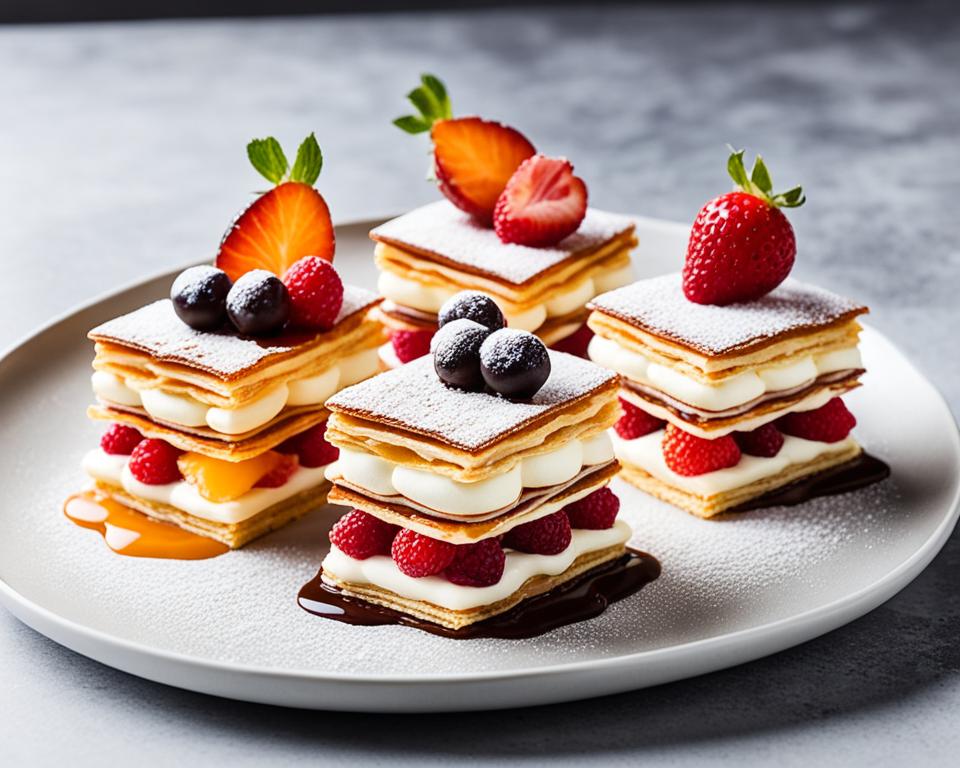
These inspired renditions of the layered dessert offer not only new flavors but also memorable experiences. The versatility of the Flaky Mille-Feuille ensures that it remains a cherished centerpiece no matter how it is fashioned, promising delight in every reinterpretation.
Serving and Presentation: Showcasing Your Mille Feuille
The crowning moment of any pastry chef’s efforts lies in the impeccable presentation of their creation. For the revered Mille Feuille, renowned as a quintessential Classic French dessert, its serving and slicing herald the pinnacle of a layered dessert’s journey from kitchen to table.
Choosing the Right Serving Dish
A dessert as refined as a Mille Feuille, with its exquisitely Mille feuille layers, demands a serving dish that complements its elegance. A pristine, white porcelain plate or a crystal-clear glass platter can be ideal choices. These serve not only as a functional base for the pastry but also as a canvas that accentuates the depth of color and layered construction of this signature French pastry.
Cutting for Elegance: Slicing the Mille Feuille
With a dessert so intricately layered, the act of slicing can make or break the aesthetic appeal of each serving. The key to preserving the Mille Feuille’s integrity is to use a sharp, serrated knife, allowing for a clean cut that maintains the distinct, flaky stratifications. The manner of slicing is a precision art, delivering uniform pieces that reveal the harmonious blend of crisp pastry and creamy filling—a delight for both the eyes and the palate. Below is a table highlighting the steps that guarantee the Mille feuille layers are served with finesse.
| Preparation | Slicing Tips | Presentation |
|---|---|---|
| Carefully transfer to the chosen dish | Use a serrated knife with gentle sawing motion | Arrange artfully to showcase layers |
| Assure the Mille Feuille is fully chilled | Measure and mark before slicing | Use garnishes that complement the flavors |
In providing these tailored serving suggestions, we ensure that the Mille Feuille—a layered dessert par excellence—receives the showcase it so richly deserves, culminating in a gastronomic temptation that evokes the allure of fine French pastry with every slice.
Navigating Common Challenges with Flaky Mille-Feuille
Creating the perfect Flaky Mille-Feuille can be as challenging as it is rewarding, often leading to a deliciously layered dessert that is the hallmark of accomplished patisseries. However, common troubles such as an over-risen pastry or imbalanced cream distribution can mar the delicate equilibrium required for this classic French confection. By pinpointing these issues and exploring the methods to overcome them, bakers can assure that each Homemade mille feuille is a reflection of the finesse and quality this dessert is known for.
When the puff pastry rises too much, the result can be a Mille feuille recipe that loses the exquisite layered texture essential to the pastry’s identity. To combat this, we embrace the technique of pressing the dough during baking. Delicate yet firm pressure, provided by a second baking sheet, ensures the pastry achieves an optimal rise. This method encourages flakiness without overexpansion, yielding a base that is poised for layering with pastry cream.
Equally crucial to the success of the Flaky Mille-Feuille is the even distribution of pastry cream. It has to be as perfect as the puff pastry itself. A pastry bag fitted with a smooth tip aids in applying uniform layers of cream, preventing irregularities that might result in a tilted or unstable dessert. To guide this process, consider the following table:
| Challenge | Cause | Solution |
|---|---|---|
| Over-Risen Pastry | Insufficient Pressing | Use a second baking sheet with weight during baking for controlled rise |
| Uneven Layers | Imprecise Pastry Cream Distribution | Use a pastry bag for even distribution of cream between layers |
In summary, diligent attention to these pivotal points in crafting a Mille feuille layered dessert is what separates the aspiring bakers from the skilled patissiers. It is a pursuit where each detail matters, each layer counts, and where triumph over these common challenges is met with the unparalleled delight of a perfectly constructed Homemade mille feuille.
Pairings for the Perfect Mille Feuille Experience
The art of indulging in a Flaky Mille-Feuille doesn’t end with its crisp layers and luscious filling. A truly memorable delicious pastry dessert experience involves the interplay with carefully chosen pairings that complement and enhance the subtle notes of this French pastry.
Selecting Beverages to Complement the Pastry
Finding the perfect liquid accompaniment for Mille Feuille is akin to selecting a fine wine to go with a gourmet meal; each sip should harmonize with the pastry’s textures and tastes. A warm, smoothly roasted coffee provides a rich contrast that makes the sweet, creamy layers of the dessert sing. On the other hand, a glass of sparkling dessert wine, with its effervescent qualities, can cleanse the palate and add an elegant touch that pairs splendidly with the velvety vanilla cream in each Mille feuille layer.
Accompaniments to Elevate Your Dessert
Beyond beverages, the choice of accompaniments can turn the act of enjoying a Mille Feuille into a feast for the senses. Fresh fruits, such as ripe berries or thin slices of pear, can introduce a refreshing and slightly tart contrast that beautifully cuts through the richness. For those who favor an added layer of decadence, a dollop of lightly whipped cream can complement the airy puff pastry, ensuring that every bite is as heavenly as the last.
These pairings not only enhance the flavors but also serve as a beautiful presentation that captivates the eyes. Whether you’re concluding a fine dining experience or savoring a quiet moment of indulgence, these thoughtful touches make each serving of Mille Feuille a celebration of French pastry tradition and contemporary culinary elegance.
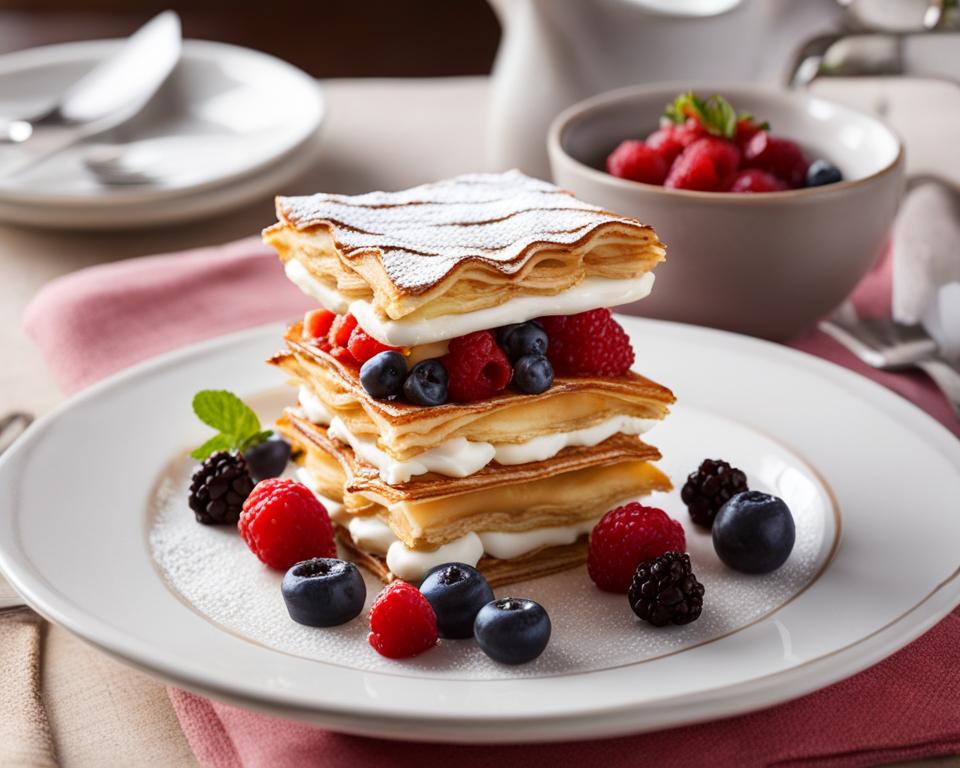
Rewards of Patience: Chilling Your Mille Feuille Properly
The quintessential final step in the journey of making a homemade mille feuille underscores the anticipation that builds as this classic French dessert sets to perfection. The chilling process is not merely a pause in action; it is an active and crucial phase that ensures the impeccable presentation and taste of those sought-after mille feuille layers. Here’s how patience is rewarded with a chilled, structured, and sumptuously layered dessert.
Importance of Cooling Time
As you layer the flaky puff pastry with rich vanilla pastry cream, the significance of cooling time becomes apparent. It’s not just about waiting; it’s about letting the assembled masterpiece mature gracefully in the cool confines of your refrigerator. This allows the pastry cream to firm, ensuring that each slice holds its shape and delivers the full sensory experience that mille feuille promises. Cutting into a mille feuille that has been cooled properly is akin to slicing through culinary history—one that’s layered with precision and tradition.
Keeping Layers Crisp While Chilling
To maintain the crispness of each layer during chilling, cover the homemade mille feuille with a dome of sorts, fashioned from loose plastic wrap, preventing any direct contact that could potentially impose moisture upon the pastry’s delicate surface. This act of safeguarding preserves the integrity of each tier, keeping the puff pastry dry and the textured contrast between cream and crunch absolutely divine.
| Component | Cooling Step | Benefit |
|---|---|---|
| Puff Pastry Layers | Cool before assembly | Retains flaky texture |
| Pastry Cream | Chill until firm | Solidifies for clean slicing |
| Assembled Mille Feuille | Refrigerate before serving | Ensures structure & taste integrity |
In essence, the artistry of preparing a sublime French pastry like mille feuille culminates in a calming cool-down, a process where time is the secret ingredient that transforms good into magnificent.
The Joy of Sharing a Homemade Mille Feuille
A homemade mille feuille is more than a delicious pastry dessert; it’s a creation infused with dedication and the essence of quality French pastry tradition. Serving this layered dessert at any gathering is not just a gesture of hospitality but also an act of shared culinary celebration, elevating any event into a memorable occasion.
Creating Memories with Layered Dessert
Each layer of a homemade mille feuille carries not just the delicate mix of butter and cream but also the story of its making. The process, often filled with meticulous effort and anticipation, culminates in a magical moment where the dessert is finally ready to be shared. Through the ritual of slicing and serving, guests are invited to partake in a shared experience that’s both sensory and sentimental. It’s a moment where the bonds of friendship and family are strengthened over shared admiration for this opulent French pastry.
A Treat for All Occasions
The mille feuille is versatile, a delicious pastry dessert befitting any number of events. From birthdays to book clubs, a layered dessert like this speaks to the universal language of patisserie appreciation. It is an offering of sweetness that is always appropriate, treating every palate to the velvety indulgence of vanilla cream tucked between ethereal layers of pastry.
- For informal gatherings, it inspires joy and casual delight.
- In formal settings, it adds a dash of refinement and sophistication.
- As part of a holiday feast, it brings a touch of tradition and nostalgia.
In a world brimming with dessert options, the homemade mille feuille stands apart as a testament to the time and skill invested in its creation. Whether it graces a family dinner table or a festive banquet, it is always received with admiration and leaves behind a memory of shared joy—a testament to the enduring charm of classic French pastry.
Conclusion
In the pursuit of perfecting the Classic French dessert, we’ve journeyed through the delicate layers of the Flaky Mille-Feuille, each step reflecting the impeccable art of French patisserie. The Mille feuille recipe presented is a testament to the finesse required to balance buttery crispness with lush pastry cream—a dance of flavor and texture that culminates in a truly Delicious pastry dessert. Whether it serves as the centerpiece of a grand soirée or a simple afternoon treat, the Mille Feuille’s appeal lies in its versatility and the sheer delight it brings to all who savor it.
From the selection of quality puff pastry to the intricacies of preparing smooth vanilla bean pastry cream, every element plays a part in forging a dessert that resonates with tradition while inviting innovation. The elegance inherent in its presentation, coupled with the joy it elicits with each flaky bite, reaffirms the Mille Feuille’s standing as more than a mere confection; it is an exuberant expression of culinary heritage.
As connoisseurs of fine desserts and ambitious home bakers alike will attest, mastering the Mille Feuille is both a challenge and a reward. It beckons not just to be eaten, but to be experienced. Its layers, as intricate as the pages of history, bind together timeless taste and artistry, serving as a homage to the legacy of Classic French dessert making. Thus, the Mille Feuille is not just a staple of patisserie—it’s a cherished experience, a testament to the craft and a joy to share, emblematic of life’s most indulgent moments.
FAQ
What makes a Mille-Feuille flaky?
The flakiness in a Mille-Feuille is achieved through the use of high-quality puff pastry dough that rises and separates into thin, crispy layers during baking.
Can I use store-bought puff pastry for making Mille-Feuille?
Yes, you can use a store-bought frozen puff pastry dough for convenience and consistent results, making sure it’s properly thawed before use.
What is the importance of vanilla bean in the pastry cream?
Vanilla bean provides a rich and aromatic flavor to the pastry cream, infusing it with the essence of vanilla that’s characteristic of an authentic French dessert.
How do I prevent my Mille-Feuille pastry from becoming soggy?
To prevent sogginess, assemble the Mille-Feuille close to serving time and ensure the puff pastry is baked until golden and fully crisped.
What are some variations I can try with the classic Mille-Feuille recipe?
You can explore with flavors like cannoli cream or coconut, or add fruit layers, chocolate, or coffee-infused pastry cream for a personalized twist on the classic recipe.
How do I cut the Mille-Feuille neatly without crushing the layers?
Use a serrated knife and gentle sawing motion to cut through the layers. Chilling the Mille-Feuille before cutting can also help maintain the layers’ integrity.
How long should I chill the Mille-Feuille before serving?
Chill the Mille-Feuille for at least 1 to 2 hours to allow the pastry cream to set and the puff pastry layers to firm up, ensuring a crisp texture.
Can Mille-Feuille be made in advance?
You can prepare the components in advance, but it’s best to assemble the Mille-Feuille shortly before serving to preserve the texture of the puff pastry.
How do I achieve the chevron icing design on a Mille-Feuille?
After icing your Mille-Feuille, use a toothpick to draw alternating lines in opposite directions. Then drag the toothpick perpendicularly through the lines to create a chevron pattern.
What beverages pair well with Mille-Feuille?
A smooth coffee or a sweet dessert wine like Moscato pairs beautifully with Mille-Feuille, as they complement the rich and creamy texture without overpowering the dessert.

